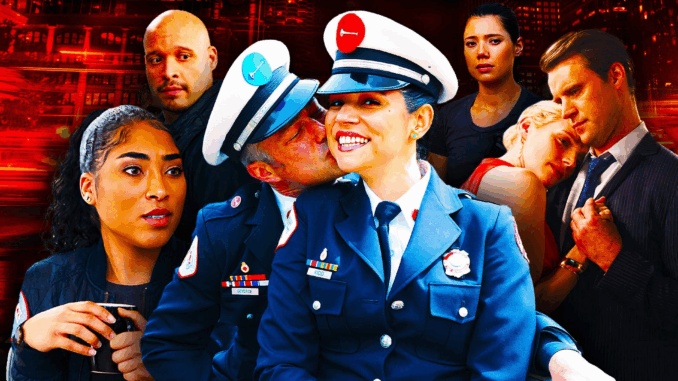
Why Character Bonds Matter More Than Explosions
On the surface, Chicago Fire might look like an action-heavy procedural—burning buildings, dramatic rescues, and near-death moments in almost every episode. But ask any longtime fan what keeps them coming back season after season, and they’ll likely say the same thing: the relationships.
From intense romances to deep friendships and mentor-mentee dynamics, Chicago Fire has built a reputation for emotional storytelling. These bonds form the heart of Firehouse 51, elevating the series beyond its procedural format into something more personal—and more powerful.
Found Family at Firehouse 51
More than just coworkers, the firefighters and paramedics of Firehouse 51 operate like a family. They eat together, argue like siblings, and rely on each other in life-threatening situations. That camaraderie is a core theme, and one of the show’s most emotionally resonant elements.
Whether it’s Severide and Casey’s longstanding brotherhood, Herrmann’s fatherly guidance, or Boden’s quiet strength as chief and surrogate parent to the whole team, the show captures what it means to belong.
This dynamic is especially important in a job that constantly faces trauma, loss, and danger. It’s not just about who rushes into the flames—it’s who’s waiting when you make it out.
Romance With Real Stakes
Over 13 seasons, Chicago Fire has delivered some of the most memorable love stories on television. From fan-favorite couples like Dawsey (Gabriela Dawson and Matthew Casey) to Stellaride (Stella Kidd and Kelly Severide), romance has always played a central role.
But what makes these relationships compelling is how grounded they are. The characters argue, break up, reunite, and face the consequences of their decisions. Kidd and Severide’s recent struggles, for example, highlight the difficulty of balancing two high-pressure careers with a marriage. Their on-and-off dynamic isn’t just drama for drama’s sake—it reflects real emotional tension.
Even more casual romances on the show, like Violet and Hawkins or Brett and Casey, have been treated with emotional depth, leaving a lasting impression on viewers.
Friendships That Anchor the Story

Romantic relationships may grab headlines, but it’s the friendships that keep Chicago Fire emotionally grounded. The partnership between Cruz and Severide has evolved from occasional banter to mutual respect. Herrmann and Mouch have remained constants for over a decade, providing both comic relief and moments of surprising wisdom.
One underrated dynamic is the sister-like friendship between Violet Mikami and Sylvie Brett. The two paramedics leaned on each other through grief, heartbreak, and professional challenges, especially after the tragic loss of Hawkins in Season 11.
These friendships are rarely flashy, but they create the emotional scaffolding that supports the show’s most dramatic moments. When someone gets hurt, transferred, or leaves the firehouse, it matters because of these bonds.
Mentorship and Growth
Mentorship is another quiet but essential theme. Chief Boden has long served as the moral center of Firehouse 51. His leadership style—stern but compassionate—shapes the careers and personal development of nearly every character.
We’ve seen characters like Kidd rise through the ranks under his guidance, and others like Gallo, Ritter, and Carver wrestle with their place in the firehouse hierarchy. These arcs give the show a sense of continuity and realism. No one stays a rookie forever, and even seasoned firefighters make mistakes.
With newer characters stepping into bigger roles, Season 14 could bring fresh mentor-mentee dynamics, especially as Firehouse 51 adjusts to multiple departures.
Grief and Healing Together
Few shows handle grief with the care that Chicago Fire does. The deaths of characters like Leslie Shay, Otis, and Evan Hawkins weren’t just shocks—they had long-lasting emotional impact on the crew.
The aftermath of Shay’s death in Season 3 haunted Severide for years. Otis’ passing in the Season 8 premiere left Cruz shattered, and that grief still lingers in quieter moments. Violet’s breakdown after losing Hawkins showed how personal tragedy can affect performance and mental health.
But these moments also highlight one of the show’s greatest strengths: healing together. The firehouse doesn’t just move on—it adapts, remembers, and supports its own.
Why These Relationships Matter More Than Ever
As Chicago Fire heads into Season 14 with a reduced budget, fewer episodes, and cast shakeups, fans may worry about the emotional weight of the show being diluted. But in many ways, this could refocus the series on what it does best: character-driven storytelling.
Without the ability to rely on large-scale stunts every episode, writers may lean more heavily on the relationships that have kept audiences engaged for over a decade. Smaller moments—like a heart-to-heart at Molly’s, a shared laugh after a tough shift, or a quiet moment of reflection—can carry just as much emotional weight as any rescue scene.
And with major characters like Ritter and Carver gone, there’s room for new relationships to form, tested by the same pressures that have shaped 51 from the start.
The Fire May Fade, But the Bonds Endure
Action keeps you on the edge of your seat—but it’s emotion that keeps you coming back. In Chicago Fire, the true sparks come from loyalty, love, grief, and growth. And no matter what changes in Season 14, the heart of Firehouse 51 will always beat strongest through its people.
